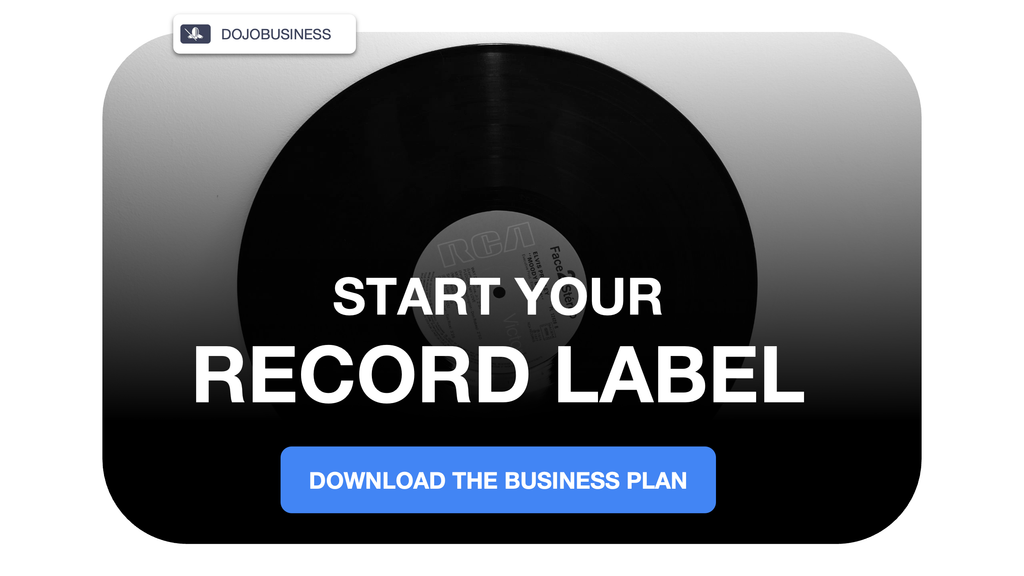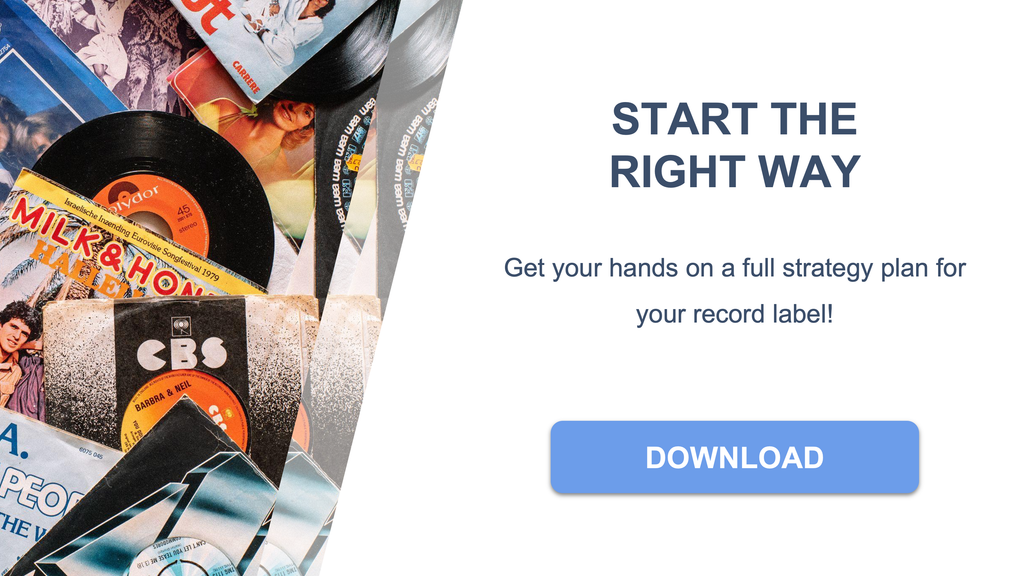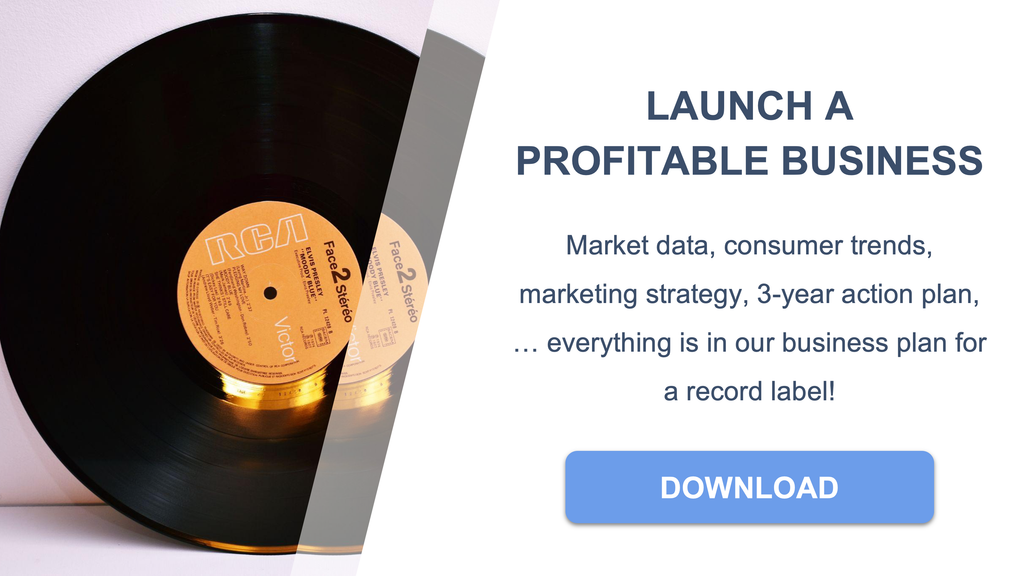This article was written by our expert who is surveying the industry and constantly updating the business plan for a record label.

Understanding the financial benchmarks of the record label industry is critical for anyone starting in this business.
Revenue, profit margins, and operating costs vary dramatically between independent labels and major players, with streaming now dominating the revenue mix. If you want to dig deeper and learn more, you can download our business plan for a record label. Also, before launching, get all the profit, revenue, and cost breakdowns you need for complete clarity with our record label financial forecast.
Record labels operate in a rapidly evolving industry where streaming dominates revenue streams and profit margins depend heavily on efficient cost management.
Independent labels typically maintain leaner operations with net margins of 10-15%, while major labels work with billion-dollar revenues but face tighter margins of 5-7% due to extensive infrastructure and overhead costs.
| Financial Metric | Independent Labels | Major Labels |
|---|---|---|
| Annual Revenue | Under $125,000 to $2 million (some reach $5-10 million) | Multi-billion-dollar range (combined global revenues exceed $20 billion annually) |
| Primary Revenue Source | Streaming (62-67%), followed by physical sales (17-20%) | Streaming (62-67%), followed by physical sales (17-20%) |
| Operating Costs | 70% of revenue (efficient management) | 85%+ of revenue (higher infrastructure and global overhead) |
| Gross Profit Margin | 50-70% (low COGS, high digital margins) | 50-70% (low COGS, high digital margins) |
| Net Profit Margin | 10-15% (leaner operations) | 5-7% (larger overheads and promotional spends) |
| Marketing Expenses | 20-25% of revenue | 20-25% of revenue (higher absolute amounts) |
| Break-Even Point | 500,000-1 million streams for singles; 1,000-5,000 physical units sold | Higher thresholds due to larger advances and marketing budgets |
| Artist Royalty Range | 10-30% of revenue | 10-30% of revenue |

What is the typical annual revenue range for independent record labels versus major labels?
Independent record labels typically generate annual revenues ranging from under $125,000 for the smallest operations up to $1-2 million for well-established indie labels.
Some exceptional independent labels with strong artist rosters and effective distribution can reach $5-10 million in annual revenue. These higher-performing indies usually have multiple successful artists, diversified revenue streams, and efficient operational structures that maximize profitability.
Major record labels—specifically Universal Music Group, Sony Music Entertainment, and Warner Music Group—operate at a completely different scale. These global corporations regularly post annual revenues in the multi-billion-dollar range, with their combined global revenues often surpassing $20 billion per year.
The revenue gap between independents and majors reflects fundamental differences in business models, artist rosters, global infrastructure, and market reach. Major labels invest heavily in international distribution networks, large marketing campaigns, and extensive artist development programs that drive substantially higher revenues but also require proportionally larger operational costs.
What percentage of revenue comes from streaming, physical sales, digital downloads, licensing, and live events?
Streaming has become the dominant revenue source for record labels, accounting for 62-67% of global revenues in 2025.
Physical sales, including CDs and vinyl records, contribute approximately 17-20% of total revenue. Vinyl has experienced notable year-on-year growth, with collectors and audiophiles driving demand for limited editions and high-quality pressings.
Digital downloads now represent less than 10% of record label revenues and continue to decline as streaming platforms dominate consumer behavior. Licensing income—which includes synchronization deals for film, television, and advertising, as well as performance rights—combined with live event-related income such as merchandise and performance royalties, contributes the remaining 10-15% of revenue.
You'll find detailed market insights in our record label business plan, updated every quarter.
This revenue breakdown has shifted dramatically over the past decade, with streaming replacing digital downloads as the primary digital format and physical sales stabilizing after years of decline.
What are the average operating costs as a percentage of revenue for record labels of different sizes?
| Cost Category | Independent Labels | Major Labels |
|---|---|---|
| Total Operating Costs | 70% of annual revenue (efficient operations) | 85%+ of annual revenue (extensive infrastructure) |
| Artist Royalties | 10-30% of revenue, depending on contract structures | 10-30% of revenue, with higher absolute amounts |
| Marketing & Distribution | Approximately 20% of total expenses | Approximately 20% of total expenses (significantly higher absolute spending) |
| Administration & Legal | 5-10% of operating costs | 5-10% of operating costs (larger legal teams and compliance requirements) |
| Production Costs | Variable, often lower due to smaller artist rosters | Variable, higher due to larger artist rosters and premium production standards |
| Overhead & Infrastructure | Lower due to lean operations and flexible structures | Higher due to global offices, extensive staff, and corporate infrastructure |
| Artist Advances | Smaller advances, more conservative approach | Larger advances, higher financial risk |
What is the typical gross profit margin in the record label business today?
Gross profit margins in the record label industry typically fall between 50% and 70%, driven primarily by low cost of goods sold and high margins on digital products.
Digital distribution has dramatically reduced the cost of delivering music to consumers compared to physical manufacturing and logistics. Streaming platforms and digital download services require minimal physical infrastructure, which allows labels to maintain strong gross margins.
Physical product sales, particularly vinyl and CDs, carry higher production and distribution costs but still generate healthy margins, especially for limited editions and premium releases. Labels that balance digital dominance with strategic physical releases optimize their gross profit margins.
The shift toward digital has fundamentally improved the gross margin structure of the record label business, making it more financially attractive for both independent and major players.
What are the common net profit margins after accounting for marketing, distribution, royalties, and overhead?
Net profit margins for record labels typically range from 5% to 10% after all operating expenses are deducted.
Independent labels often achieve higher net profit margins—commonly between 10% and 15%—due to leaner operational structures, lower overhead costs, and more flexible business models. Indie labels can adapt quickly to market changes, negotiate favorable distribution deals, and maintain tight control over expenses.
Major labels, despite their massive revenues, typically see lower net profit margins of 5-7%. Their extensive global infrastructure, large marketing budgets, substantial artist advances, and corporate overhead significantly reduce profitability as a percentage of revenue.
Marketing, distribution, royalty payments, and administrative costs are the primary factors that compress net margins. Labels must carefully balance investment in artist development and promotion against the need to maintain profitability, especially when dealing with non-recouped advances.
This is one of the strategies explained in our record label business plan.
How do artist advances and royalty structures affect profitability and cash flow?
Artist advances are upfront loans provided to artists that must be recouped from future royalty earnings, and they directly impact label cash flow and profitability.
When a label signs an artist, it typically provides an advance that covers recording costs, living expenses, and initial promotional activities. This advance is recouped before the artist receives any additional royalty payments. If a release underperforms and the advance is not fully recouped, the label absorbs the loss, which directly reduces profitability.
Royalty structures typically allocate 10-30% of revenue to artists under standard label deals. However, all major costs—including marketing, production, distribution, and administration—are deducted before calculating royalties. This structure ensures that labels cover their expenses first, but it also means that profitability is heavily dependent on successful releases that recoup advances and generate sustained revenue.
Large advances create significant financial risk, particularly for new or unproven artists. Labels must carefully assess potential return on investment before committing substantial upfront capital. Non-recouped advances represent one of the most significant drags on profitability in the record label business.
Cash flow management is critical, as labels must balance the timing of advance payments, marketing expenditures, and incoming revenue from streaming, sales, and licensing. Effective cash flow management separates financially healthy labels from those that struggle with liquidity.
What share of expenses goes to marketing, promotion, and content creation versus administration and overhead?
Record labels typically allocate 20-25% of their revenue to marketing, promotion, and content creation, particularly for major releases and touring artists.
Marketing and promotional expenses include digital advertising, radio promotion, playlist pitching, music video production, social media campaigns, and public relations efforts. These costs are essential for building artist visibility and driving streaming numbers, sales, and licensing opportunities.
Administration and overhead account for approximately 10-15% of total expenses. This includes salaries for executive staff, legal fees, accounting services, office rent, technology infrastructure, and general corporate operations. Independent labels generally maintain lower administrative costs due to smaller teams and flexible work arrangements.
The shift to digital distribution has reduced some traditional overhead costs, such as physical warehousing and shipping logistics. However, labels have increased spending on digital marketing, data analytics, and technology platforms to remain competitive in the streaming-dominated market.
Major labels spend significantly more in absolute terms on both marketing and administration, but as a percentage of revenue, the proportions remain similar to independent labels. The key difference lies in the scale and global reach of their operations.
What are the average break-even points for new releases in terms of units sold or streams?
For streaming, an independent label typically needs 500,000 to over 1 million streams per single to cover production, artist advance, marketing, and distribution costs.
The exact break-even point depends on the size of the artist advance, the quality and cost of production, and the intensity of the marketing campaign. Labels that invest heavily in high-profile artists or premium production require significantly higher streaming numbers to break even.
For physical releases, break-even typically occurs at 1,000 to 5,000 units sold. Vinyl releases, which have higher production costs but also higher retail prices, may break even at the lower end of this range if marketed effectively to collectors and dedicated fans.
Break-even calculations must account for all direct costs, including recording and production expenses, advance payments, marketing and promotional spending, distribution fees, and royalty obligations. Labels that carefully manage these costs and target the right audiences achieve break-even more quickly.
We cover this exact topic in the record label business plan.
How do revenue and profit margins vary between genres and markets?
Pop music commands the largest market share and generates the most robust profit margins, accounting for over 28% of global music consumption.
Pop benefits from higher streaming numbers, broader global appeal, and strong commercial licensing opportunities. Pop artists often achieve mainstream radio play and playlist placements, driving both revenue and profitability.
Latin, hip-hop, and electronic genres generate high streaming income but face more competitive markets with rapid artist turnover. These genres can yield strong revenues but often require continuous investment in discovering and promoting new talent, which compresses profit margins.
Niche genres such as jazz, classical, and folk may yield higher profit margins for independent labels focused on dedicated fan bases despite lower overall streaming volumes. These labels benefit from loyal audiences willing to purchase physical products, attend live events, and support crowdfunding campaigns.
Geographic markets also affect revenue and profitability. North America and Europe remain the largest markets, but Latin America and Asia are experiencing rapid growth in streaming adoption. Labels that effectively navigate regional preferences and distribution channels can capitalize on these emerging opportunities.
What benchmarks exist for return on investment when signing new artists?
| Label Type | ROI Timeframe | Expected Return |
|---|---|---|
| Major Labels | 2-3 years | Successful artists should at least double the initial advance through cumulative album sales, streaming revenue, merchandise, and touring income |
| Independent Labels | 12-18 months | Indies typically use leaner ROI targets and aim for faster recoupment of advances and profitability due to smaller upfront investments |
| Emerging Artists | Variable | High-risk, high-reward; some artists break even or fail to recoup, while others generate multiples of the initial investment |
| Established Artists | 1-2 years | More predictable ROI due to existing fan bases; labels expect steady revenue from streaming, touring, and licensing |
| Genre-Specific | Varies by genre | Pop and hip-hop offer faster ROI potential; niche genres may take longer but offer more stable, long-term returns |
| Catalog Revenue | Ongoing | Successful artist signings generate long-term catalog revenue from streaming and licensing, often exceeding initial projections |
| Failed Signings | N/A | Non-recouped advances are written off as losses; labels mitigate risk through diversified artist portfolios |
How do independent labels' margins compare to those of major labels in current market conditions?
Independent labels consistently achieve higher net profit margins than major labels, typically in the range of 10-15% compared to 5-7% for majors.
This margin advantage stems from significantly lower overhead costs, more adaptable business models, and leaner organizational structures. Independent labels operate without the extensive global infrastructure, corporate bureaucracy, and large staffing requirements that burden major labels.
Major labels invest heavily in artist development, international marketing campaigns, and large advance payments, which generate substantial revenues but compress profit margins. Their complex organizational structures and global operations require ongoing investment in technology, compliance, and administrative systems.
Independent labels benefit from direct relationships with artists, flexible distribution arrangements, and the ability to pivot quickly in response to market trends. They often partner with independent distribution networks or digital platforms that provide cost-effective access to global audiences without the overhead of maintaining proprietary distribution systems.
In current market conditions, the rise of streaming and digital distribution has leveled the playing field, allowing independent labels to compete effectively with majors. Indies can achieve profitability with smaller artist rosters and lower revenue thresholds, making them more financially resilient in volatile market environments.
What are the key financial risks that most directly impact revenue and profitability in the record label industry?
- Non-recouped artist advances: Large upfront payments to artists that fail to generate sufficient revenue represent direct losses that reduce profitability and strain cash flow.
- High royalty payout commitments: Fixed royalty obligations that are independent of sales performance can erode margins, particularly when releases underperform or streaming rates fluctuate.
- Over-investment in marketing: Excessive spending on promotion without proportionate increases in sales or streams diminishes returns and impacts profitability, especially for unproven artists or saturated markets.
- Volatility in streaming rates: Changes in per-stream payouts from platforms like Spotify, Apple Music, and YouTube directly affect revenue predictability, particularly for labels reliant on streaming for the majority of their income.
- Declining physical sales: Continued erosion of CD sales and unpredictable vinyl demand create revenue uncertainty, especially for labels with significant investments in physical inventory and distribution.
- Rapid platform revenue-sharing changes: Shifts in how streaming platforms distribute revenue among rights holders can dramatically impact label income, requiring constant adaptation to new business models.
- Non-recourse production and licensing costs: Expenses incurred in recording, producing, and licensing music that cannot be recovered if a release fails represent significant financial risk, particularly for high-budget projects.
Conclusion
This article is for informational purposes only and should not be considered financial advice. Readers are encouraged to consult with a qualified professional before making any investment decisions. We accept no liability for any actions taken based on the information provided.
Understanding the financial landscape of the record label industry is essential for anyone considering entering this business.
By carefully managing operating costs, navigating artist advances, and leveraging the shift to streaming, both independent and major labels can build sustainable and profitable operations in today's dynamic music market.
Sources
- AIR Share Report
- Business Plan Templates - Record Label Revenue
- Music Business Worldwide - Major Label Revenue
- IFPI Global Music Report 2023
- IFPI Global Music Report 2025
- Mordor Intelligence - Music Market
- Business Plan Templates - Record Label Operating Costs
- Dojo Business - Record Label Profitability
- FinModelsLab - Music Label Operating Costs
- Curve Royalty Systems - Record Label Deals




